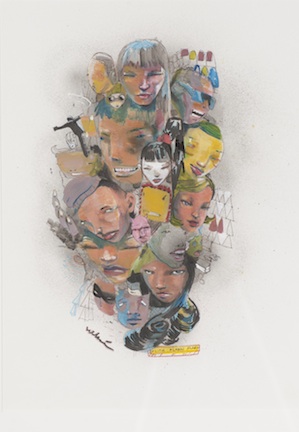Local Artist Blends History and Culture to Create New Generation Art (original) (raw)
Feature Mon Apr 25 2011
This article was submitted by freelance writer Iya Bakare.

Is Chicago ready for Hebru Brantley's artwork?
Probably not.
Well, ready or not, he's here and said he wants to go as loud as he can to tell stories through his work in a non-traditional way.
"You have to have a home base to blow up," said Brantley. "I've been blessed and fortunate enough to build a base here and now I'm ready to conquer the rest of the world."
The Chicago native said this city is the best place to establish that home base. Brantley said his recent solo exhibition, Afro-Futurism: Impossible View, served as a major stepping stone in his young career, as the first African-American under the age of 30 (at the time) to be featured at the Zhou B. Art Center in Bridgeport-- not far from his stomping ground of Chicago's Bronzeville neighborhood. In this exhibit, his illustrations depict stories surrounded by his creation of a superhero named Flyboy and other goggle-eyed creatures--children specifically--and their emotions from today's socioeconomic times and a group of World War II unsung heroes-- The Tuskegee Airmen.
Brantley said the idea of Flyboy developed after he read one of his father's books about the Tuskegee Airmen, with whom he developed an admiration. He started sketching and drawing images of the authentic and raw emotions of these goggle-eyed kids, which is one of Brantley's identifying styles.
"Imagine being God-like for a moment in time and coming back to racial tension and being seen as less than human," said Brantley, as he discussed historical events.
These sketches were created into mythological comic heroes and fused with Japanese anime to tell stories of the highs and lows of society in the past and today.
Stanford W. Carpenter, Ph.D., an ethnographer and assistant professor of visual and critical studies at the School of the Art Institute of Chicago, said Brantley's work deals with a different art audience and taps into ethnography.
"He [Brantley] is a part of a movement that will continue to grow and challenges the definition of art and comics, which is a good thing," said Carpenter. "The range in art is expanding, and so is the age range that follows art. He's responding to culture and this is significant because artists can play with identity in the art form. Artists like Hebru Brantley are on the vanguard of the integration of art."
Brantley said he wants to give back and leave a legacy in his work, and wants to connect with all audiences.
"Gallery art can be approachable and my work tells a story you can identify with," he adds. "To be able to create and have people pay attention to it...there's no better feeling."
"He's able to play with identity and articulate it in his work in a way that he couldn't do in other forms," said Carpenter.

Brantley, a self-taught visual artist, said he originally studied film in college in Atlanta, but wanted to express himself in a different art form, and taught himself how to paint and illustrate, which he also added feels more natural to him. Brantley said while he was in Atlanta, he transitioned his work on walls as a graffiti artist and media production illustrator to paintings and drawings on a canvas. After college, the young artist spent some time in New York and Los Angeles, before he moved back to Chicago to establish his home base.
Regarding his recent exposure, Brantley seems exited: "Without having an inside track of the art field, I've been metaphorically walking in the dark and now I've been invited to play."
All photos courtesy of Hebru Brantley. Video by @nHarlem.
~*~
This feature is supported in part by a Community News Matters grant from The Chicago Community Trust and the John S. and James L. Knight Foundation. More information here.

